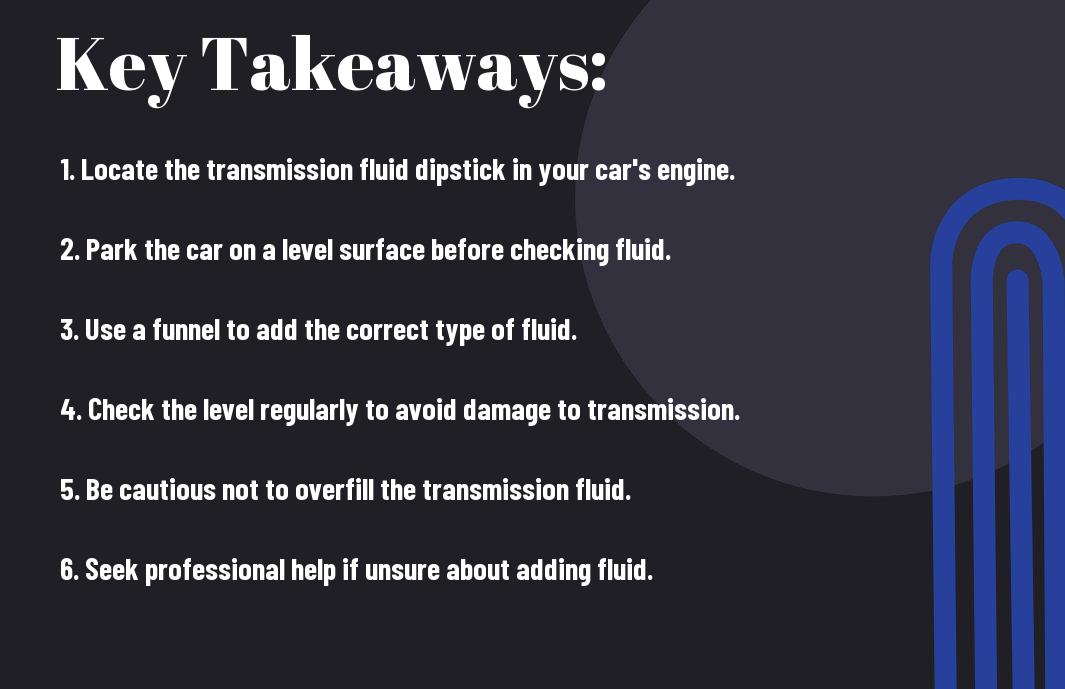Perplexed about how to add transmission fluid to your car? It may seem like a daunting task, but with the right knowledge and tools, you can easily ensure the smooth operation of your vehicle. I’ll guide you through the steps to properly add transmission fluid to your car, and provide you with essential car care and maintenance tips that will help you keep your vehicle in top condition. Before you begin, you might be wondering, “Can you add transmission fluid without changing it?” Let’s delve into the details and get you up to speed on this crucial aspect of vehicle maintenance.
Key Takeaways:
- Check your owner’s manual: Before adding transmission fluid, consult your owner’s manual to understand the specific type and amount of fluid your car requires.
- Locate the transmission fluid dipstick: To add transmission fluid, you will need to locate the transmission fluid dipstick, usually found near the back of the engine bay.
- Use a funnel for accuracy: When adding transmission fluid, use a funnel to ensure that the fluid is poured accurately and does not spill onto other engine components.
- Monitor fluid levels and quality: Regularly check your transmission fluid levels and quality to ensure that it is at the appropriate level and not contaminated. This can help prevent transmission issues and prolong the lifespan of your car.
- Seek professional help if needed: If you are unsure about adding transmission fluid or if you encounter any issues, it is best to seek the help of a professional mechanic to avoid any potential damage to your car’s transmission system.
Understanding the Transmission Fluid
Your car’s transmission fluid is a crucial component in keeping your vehicle running smoothly. The transmission fluid acts as a lubricant for the moving parts inside the transmission, helping to reduce friction and keep everything working as it should. It also helps to transfer power from the engine to the transmission, allowing your car to shift gears smoothly. If you want to learn more about how to check and add transmission fluid, you can check out this helpful guide on the topic from WikiHow.
Importance of Transmission Fluid in Car Maintenance
Proper maintenance of your car’s transmission fluid is crucial in ensuring the longevity and efficiency of your vehicle. Without enough transmission fluid, your transmission can overheat, leading to serious damage to the internal components. Additionally, dirty or low fluid levels can result in rough shifting and increased wear and tear on the transmission, potentially leading to expensive repairs. Regularly checking and adding transmission fluid is a simple yet important aspect of vehicle maintenance that can save you from costly issues down the road.
Signs of Low Transmission Fluid
Recognizing the signs of low transmission fluid is essential for preventing potential damage to your car’s transmission. If you notice delayed or rough shifting, slipping gears, or unusual noises coming from the transmission, these could be indications of low fluid levels. Ignoring these signs and allowing the fluid levels to remain low can lead to serious damage to the transmission, resulting in a hefty repair bill. That’s why it’s crucial to regularly monitor your transmission fluid levels and address any issues promptly.

Checking and Adding Transmission Fluid
Obviously, one of the most crucial aspects of car care and maintenance is checking and adding transmission fluid. Transmission fluid is essential for lubricating the moving parts of your car’s transmission, ensuring smooth gear shifts and preventing overheating. Without adequate transmission fluid, your car’s transmission can suffer damage, leading to costly repairs. In this section, I will guide you through the steps for checking and adding transmission fluid to keep your car running smoothly.
Steps for Checking Transmission Fluid Level
When checking your transmission fluid level, ensure that your car is on level ground and the engine is running. Locate the transmission fluid dipstick, which is usually found towards the back of the engine. Pull out the dipstick, wipe it clean with a cloth, reinsert it, and then pull it out again to check the level. The fluid should be within the “full” range, and it should have a pinkish or red color. If the level is low, or if the fluid appears dirty or has a burnt odor, it’s essential to add or replace the transmission fluid as soon as possible to avoid damage to the transmission. Remember to consult your car’s manual for the specific procedure for checking transmission fluid, as it may vary depending on the car model.
Steps for Adding Transmission Fluid
If the transmission fluid level is low, you can add more fluid to bring it back to the proper level. To add transmission fluid, first, locate the transmission fluid reservoir under the hood. Using a funnel, carefully pour a small amount of transmission fluid into the reservoir. After each pour, recheck the fluid level using the dipstick, and stop adding fluid once it reaches the “full” range. It’s crucial to use the type of transmission fluid recommended in your car’s manual, as using the wrong type can damage the transmission. By following these steps, you can ensure that your car’s transmission has an adequate level of fluid to function properly and avoid costly repairs in the future.
Maintenance Tips for Transmission Fluid
Despite the fact that transmission fluid is often overlooked in regular car maintenance, it is crucial to the overall health and performance of your vehicle. Here are some maintenance tips to keep your transmission fluid in good condition:
- Regular Checks: Checking your transmission fluid regularly is important to ensure there are no leaks or contamination. I recommend checking it at least once a month or as often as recommended in your car’s manual.
- Using the Right Fluid: When adding or changing transmission fluid, always ensure you are using the right type for your specific vehicle. Using the wrong type of fluid can lead to performance issues and potential damage.
- Proper Levels: Maintaining the correct level of transmission fluid is crucial for smooth gear shifting and to prevent overheating. Always make sure the fluid is at the appropriate level for optimal performance.
Recognizing the importance of these maintenance tips and incorporating them into your regular car care routine can significantly extend the lifespan of your vehicle’s transmission.
Regular Transmission Fluid Changes
Regularly changing your transmission fluid is essential for maintaining the health of your vehicle’s transmission. Over time, the fluid can break down and become contaminated, leading to decreased performance and potential damage. I recommend following the manufacturer’s recommendations for transmission fluid changes and always using high-quality fluid to ensure the longevity of your transmission.
Common Mistakes to Avoid When Adding Transmission Fluid
One of the most common mistakes when adding transmission fluid is overfilling the reservoir. This can lead to increased pressure and potential damage to the transmission. Additionally, using the wrong type of transmission fluid can also have negative consequences on performance. Always double-check your vehicle’s manual and use the recommended fluid to avoid these common mistakes.

How Do I Add Transmission Fluid? Car Care and Maintenance
From above steps, you can see that adding transmission fluid to your car is a straightforward process that can be done at home with just a few simple tools. Ensuring that you have the correct type of transmission fluid for your vehicle and following the proper steps for checking the fluid level and adding more if needed is crucial for maintaining the health and longevity of your vehicle’s transmission. By regularly checking and adding transmission fluid as needed, you can help to prevent costly repairs and keep your car running smoothly for years to come.
FAQ: How Do I Add Transmission Fluid? Car Care and Maintenance
Q: Why is it important to add transmission fluid?
A: Transmission fluid is vital for lubricating and cooling the moving parts in your vehicle’s transmission. It also facilitates smooth gear shifts and helps prevent wear and tear on the transmission system.
Q: How do I know if my transmission fluid is low?
A: You can check your transmission fluid level by locating the transmission dipstick, which is usually labeled and near the engine. Pull it out, wipe it clean, reinsert it, and then pull it out again. The fluid level should fall within the “full” range on the dipstick.
Q: What type of transmission fluid should I use?
A: Consult your vehicle’s owner’s manual to determine the correct type of transmission fluid for your specific make and model. Using the wrong type of fluid can damage your transmission.
Q: How often should I add transmission fluid?
A: In general, you should check your transmission fluid level and condition at regular intervals, such as during scheduled oil changes. If the fluid is low, you should add more to bring it back to the proper level.
Q: Can I add transmission fluid myself, or do I need a professional to do it?
A: Adding transmission fluid is a relatively simple task that you can do yourself, as long as you have the correct type of fluid and follow the instructions in your owner’s manual. However, if you’re unsure or uncomfortable with doing it yourself, it’s best to have a professional technician perform this maintenance task for you.









Leave a comment